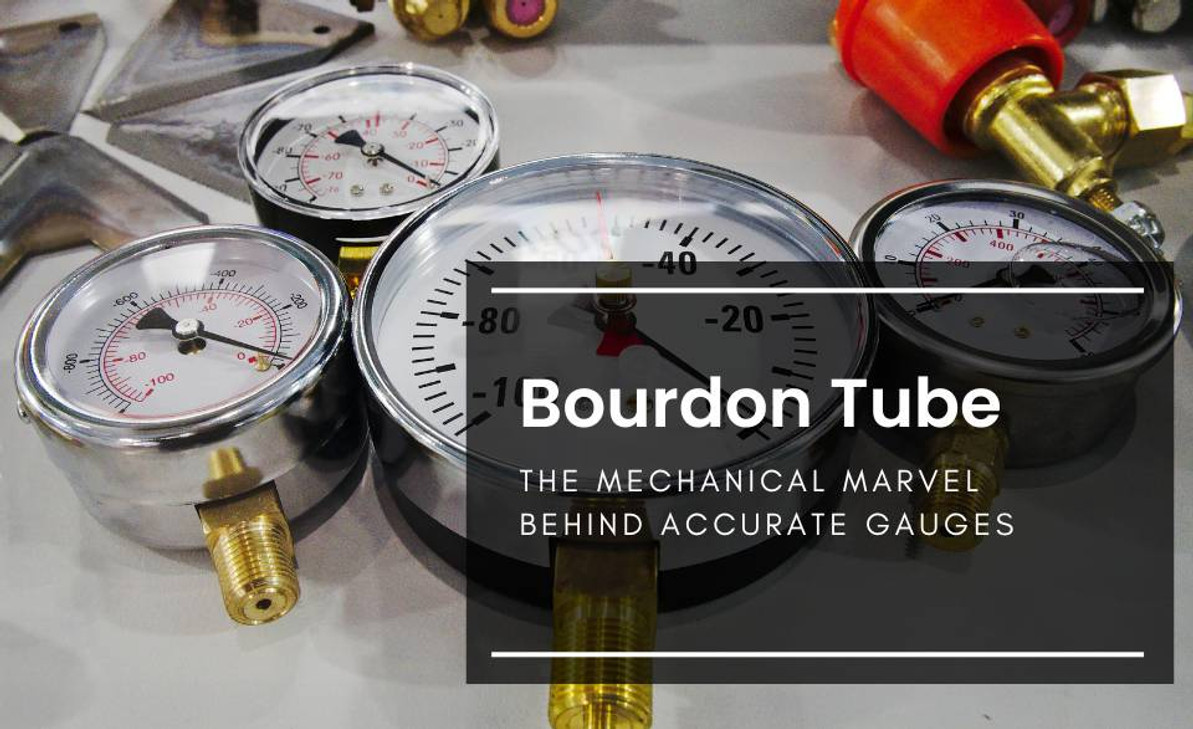Bourdon Tube: The Mechanical Marvel Behind Accurate Gauges
Introducing the world of Bourdon tubes, where simplicity meets precision in pressure measurement. Imagine a curved, resilient tube that possesses the remarkable ability to reveal the hidden forces within gases and liquids. This ingenious device, the Bourdon tube, has been an unsung hero in countless industries, providing reliable and cost-effective pressure readings for well over a century.
In this exploration, we will unravel the secrets of Bourdon tubes, delving into their fundamental principles, various designs, and the crucial role they play in applications ranging from industrial manufacturing to aerospace. Whether you're a seasoned engineer seeking to deepen your understanding or a curious mind embarking on a journey of discovery, join us as we unveil the fascinating world of Bourdon tubes—a testament to the marriage of simplicity and accuracy in pressure measurement.
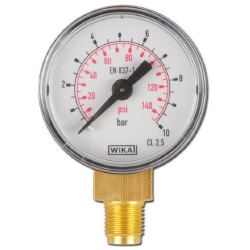
Fig 1. Bourdon tube pressure gauge
What is a Bourdon Tube?
A Bourdon tube is a mechanical pressure-sensing device used in various applications to measure the pressure of gases and liquids. It was invented by the French engineer Eugène Bourdon in the mid-19th century and has since become a widely used instrument for pressure measurement.
The Bourdon tube consists of a hollow, curved tube typically made of metal, usually in a C-shape or helical coil shape. One end of the tube is sealed, and the other end is open to the pressure being measured. When the pressure of the fluid (gas or liquid) increases, it exerts a force on the inside of the curved tube, causing it to straighten or uncoil slightly. This deformation is proportional to the pressure applied. The degree of straightening or uncoiling of the Bourdon tube is directly related to the pressure, and this deformation is used to drive a pointer or an electronic sensor to indicate the pressure reading on a gauge or display.
Bourdon tubes are commonly found in pressure gauges and transmitters used in various industries, including manufacturing, petrochemical, aerospace, and HVAC (heating, ventilation, and air conditioning) systems. They are known for their simplicity, reliability, and accuracy in measuring pressure, and they come in different shapes and sizes to suit different pressure ranges and applications. The design and material of the Bourdon tube can vary depending on the specific requirements of the application, but the fundamental principle of operation remains the same.
When was the first Bourdon Tube made?
The Bourdon tube was invented by the French engineer Eugène Bourdon in the mid-19th century. He patented his design for the Bourdon tube in France in 1849. This invention revolutionized pressure measurement technology and quickly gained widespread use in various industrial applications due to its simplicity and effectiveness in measuring pressure. Since then, the Bourdon tube has remained a fundamental component in pressure gauges and related instrumentation.
How is the Bourdon Tube construction?
The construction of a Bourdon tube involves a specific design and materials to enable it to accurately measure pressure. Here are the key components and features of a typical Bourdon tube construction:
- Tube Material: Bourdon tubes are commonly made of various materials, including stainless steel, brass, bronze, or even specialized alloys, depending on the application's requirements. The material must have the necessary mechanical properties to withstand the pressure and maintain its shape.
- Tube Shape: Bourdon tubes are typically C-shaped or helical (coil-shaped). The choice of shape depends on the desired sensitivity, pressure range, and application.
- Sealed End: One end of the Bourdon tube is sealed, and this end is connected to the pressure source or the fluid whose pressure you want to measure.
- Free End: The other end of the Bourdon tube is open to the atmosphere or connected to a reference pressure. When pressure is applied, this end of the tube will experience deformation.
- Levers and Linkages: To magnify and transfer the small angular motion resulting from the Bourdon tube's deformation, a lever system or linkages are often used. This converts the mechanical deformation into linear motion, which can then be used to drive a pointer or an electronic sensor.
- Pivot and Gear Mechanism: In pressure gauges, there is usually a pivot point or a gear mechanism that translates the linear motion into the rotational movement of a pointer on the gauge dial.
The principle of operation is relatively simple: as the pressure of the fluid inside the sealed end of the Bourdon tube increases, it exerts a force on the inside of the curved or coiled tube, causing it to straighten or uncoil slightly. This deformation is proportional to the pressure applied. The mechanical components of the gauge then amplify this deformation and convert it into a readable pressure measurement.
Bourdon tubes can be designed in various shapes and sizes to suit different pressure ranges and applications, allowing for a wide range of pressure measurement needs. Their robust and reliable design has made them a popular choice in industries where pressure measurement is crucial, such as manufacturing, petrochemicals, and many others.
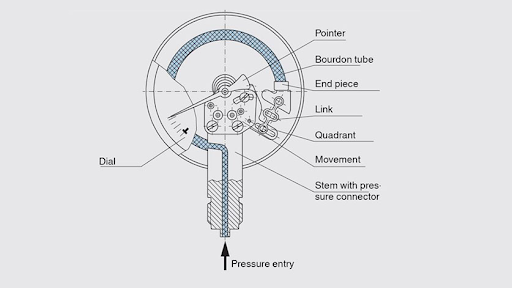
Fig 2. Bourdon tube structre
How is the Bourdon Tube functional principle?
The functional principle of a Bourdon tube is based on the mechanical deformation of a curved or coiled tube in response to changes in pressure. Here's a step-by-step explanation of how a Bourdon tube works:
- Tube Construction: The Bourdon tube is typically made of metal and is shaped like a C or a helical coil. One end of the tube is sealed, and the other end is open.
- Pressure Application: The sealed end of the Bourdon tube is connected to the pressure source or the fluid whose pressure needs to be measured. As the pressure of the fluid increases, it exerts a force on the inside of the Bourdon tube.
- Deformation: The applied pressure causes the Bourdon tube to deform. The specific shape and material of the tube are designed such that an increase in pressure leads to a corresponding change in the shape of the tube. In the case of a C-shaped Bourdon tube, it tends to straighten out slightly, while a helical coil may unwind to some extent.
- Linkage or Mechanism: To translate the deformation into a measurable output, a mechanical linkage or mechanism is often used. This converts the linear motion resulting from the Bourdon tube's deformation into rotational motion.
- Pointer Movement: A pointer is attached to the mechanism in pressure gauges. As the Bourdon tube deforms in response to changing pressure, it causes the pointer to move across a scale on the gauge's dial.
- Pressure Measurement: The position of the pointer on the scale corresponds to the pressure being measured. The scale is calibrated to provide an accurate pressure reading.
- Reference Pressure: The open end of the Bourdon tube is typically connected to a reference pressure, often atmospheric pressure. This reference pressure ensures that the measurement is relative to the atmospheric pressure, which is essential for accurate readings.
The key principle behind the Bourdon tube's operation is that the mechanical deformation of the tube is proportional to the applied pressure. This proportionality allows for accurate pressure measurements over a wide range of pressures. Bourdon tubes are known for their reliability and accuracy, and they are widely used in pressure gauges and instruments across various industries for monitoring and controlling pressure in processes and systems.
Bourdon Tube Formula
The Bourdon tube operates based on the principle that its deformation is directly proportional to the pressure applied to it. This relationship can be described using the following formula:
ΔL = (P * L) / (E * t)
Where:
- ΔL is the change in length or deformation of the Bourdon tube.
- P is the pressure applied to the sealed end of the Bourdon tube.
- L is the original length of the Bourdon tube.
- E is the modulus of elasticity (a material property) of the Bourdon tube material.
- t is the thickness of the Bourdon tube wall.
This formula provides a theoretical basis for understanding how the Bourdon tube responds to pressure changes. However, in practical applications, pressure gauges and instruments typically use calibrated mechanisms and scales to directly read the pressure, so you don't need to calculate the deformation manually. The deformation of the Bourdon tube is converted into a readable pressure value using mechanical linkages and scales on the gauge.
The specific design and calibration of a Bourdon tube pressure gauge can vary, so the exact formula for converting deformation to pressure may differ between different manufacturers and models. It's essential to refer to the manufacturer's documentation and calibration data for the specific pressure gauge in question if you need precise pressure measurements.
Example of using a formula
Let's walk through an example of how you might use the Bourdon tube formula to calculate the deformation of a Bourdon tube when a certain pressure is applied.
Suppose you have a Bourdon tube made of stainless steel with the following properties:
- Original length (L): 100 mm (0.1 meters)
- Modulus of elasticity (E) for stainless steel: 193 GigaPascals (193,000,000,000 Pascals)
- The thickness of the Bourdon tube wall (t): 1 mm (0.001 meters)
You want to calculate the deformation (ΔL) of the Bourdon tube when a pressure of 500 psi (pounds per square inch) is applied.
First, we need to convert the pressure from psi to Pascals, as the modulus of elasticity is given in Pascals: 1 psi = 6894.76 Pa (Pascals) So, 500 psi = 500 * 6894.76 Pa ≈ 3,447,380 Pa
Now, we can use the Bourdon tube formula: ΔL = (P * L) / (E * t)
ΔL = (3,447,380 Pa * 0.1 m) / (193,000,000,000 Pa * 0.001 m)
ΔL ≈ (344,738 mPa) / (193,000,000,000 mPa)
ΔL ≈ 0.00179 meters
So, when a pressure of 500 psi is applied to the Bourdon tube, it will deform by approximately 0.00179 meters (or about 1.79 millimeters).
Please note that this is a simplified example, and in practical applications, the Bourdon tube's deformation is typically calibrated and used with mechanical linkages and scales to directly read the pressure. The formula is provided here for a theoretical understanding of the Bourdon tube's principle of operation.
How many types does a Bourdon Tube have?
There are several types and variations of Bourdon tubes, each designed to suit specific pressure measurement applications and requirements. The key types of Bourdon tubes include
- C-Type Bourdon Tube: This is the most common and widely used Bourdon tube design. It is shaped like the letter "C" and is suitable for measuring both high and low pressures. C-type Bourdon tubes are known for their versatility and can be found in various pressure gauges.
- Helical Bourdon Tube: Instead of a C-shape, the helical Bourdon tube is coiled or spiral-shaped. It is often used for high-pressure applications where the C-type tube might be less effective due to its limitations in handling very high pressures.
- Spiral Bourdon Tube: This type is similar to the helical Bourdon tube but with a more tightly wound spiral coil. It provides higher sensitivity and is often used in pressure measurement applications where fine pressure control or detection of small pressure variations is crucial.
- Coil-Type Bourdon Tube: In this variation, the Bourdon tube is formed into a series of concentric coils. Coil-type Bourdon tubes are used in specialized applications that require a particular response to pressure changes or where space constraints exist.
- Sectored Bourdon Tube: This design combines multiple C-shaped segments in a single Bourdon tube assembly. Each segment may be calibrated to measure a different pressure range, allowing for a wider measurement span in a single instrument.
- Flat Spiral Bourdon Tube: This type combines a spiral design with a flatter profile, offering a compromise between the sensitivity of a spiral tube and the compactness of a C-type tube. It's often used in gauges with limited space.
- Elliptical Bourdon Tube: In this design, the Bourdon tube is shaped like an ellipse. Elliptical Bourdon tubes are used in applications where a non-linear response to pressure changes is required.
- Diaphragm-Type Bourdon Tube: These Bourdon tubes are designed in the form of a diaphragm rather than a curved tube. They are used in pressure switches and transmitters and are sensitive to very low pressures.
The choice of Bourdon tube type depends on factors such as the pressure range, sensitivity, space constraints, and the specific requirements of the application. Different Bourdon tube designs offer varying degrees of accuracy, sensitivity, and durability to meet the demands of different industries and pressure measurement scenarios.
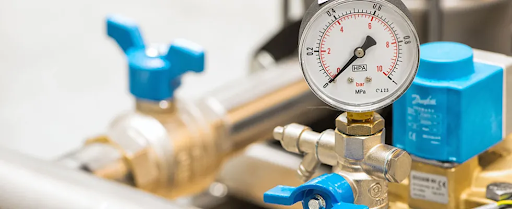
Fig 3. Bourdon tube pressure gauge
- Description: Shaped like the letter "C," this is the most common Bourdon tube design.
- Operation: As pressure increases, the tube tends to straighten out slightly.
- Pressure Range: Typically used for both low and high-pressure measurements.
- Applications: Found in a wide range of industries and applications, including HVAC systems, industrial machinery, and automotive pressure gauges.
- Pros: Versatile, cost-effective, and widely available.
- Cons: May not be suitable for extremely high-pressure applications due to limitations in handling very high pressures.
- Description: Coiled or spiral-shaped Bourdon tube.
- Operation: Unwinds as pressure increases.
- Pressure Range: Suited for high-pressure applications.
- Applications: Often used in hydraulic systems, industrial processes with high pressures, and some aerospace applications.
- Pros: Handles high pressures effectively, durable.
- Cons: Limited sensitivity for low-pressure measurements, larger compared to C-type tubes.
- Description: Tightly wound spiral coil.
- Operation: Unwinds in response to pressure changes.
- Pressure Range: Suitable for high-pressure applications.
- Applications: Used in applications where fine pressure control or detection of small pressure variations is crucial, such as laboratory instruments.
- Pros: High sensitivity, good for precise measurements in high-pressure ranges.
- Cons: Can be more delicate and expensive to manufacture.
- Description: Formed into concentric coils.
- Operation: Deforms based on pressure changes.
- Pressure Range: Application-specific, designed for specialized requirements.
- Applications: Found in unique applications where a specific response to pressure changes is needed, such as certain aerospace and research instruments.
- Pros: Can be customized for specific needs.
- Cons: Limited availability, may require specialized manufacturing.
- Description: Combines multiple C-shaped segments in one assembly.
- Operation: Each segment may be calibrated for a different pressure range.
- Pressure Range: Offers a wide measurement span within a single instrument.
- Applications: Used where multiple pressure ranges need to be measured with a single gauge, e.g., on testing equipment.
- Pros: Versatile, saves space and costs.
- Cons: More complex to manufacture and calibrate.
- Description: A flatter spiral profile.
- Operation: Similar to a spiral Bourdon tube but with a different shape.
- Pressure Range: Application-specific.
- Applications: Used when space is limited, such as in certain industrial pressure gauges.
- Pros: Compact, effective in constrained spaces.
- Cons: Limited sensitivity compared to some other designs.
- Description: Shaped like an ellipse.
- Operation: Deforms in response to pressure changes.
- Pressure Range: Application-specific.
- Applications: Used when a non-linear response to pressure changes is required, often in research or specialized applications.
- Pros: Customizable for specific applications.
- Cons: Uncommon, may require specialized manufacturing.
- Description: Diaphragm-shaped Bourdon tube.
- Operation: Deforms with very low pressures.
- Pressure Range: Suited for very low-pressure measurements.
- Applications: Found in pressure switches, transmitters, and applications requiring the detection of minute pressure variations, such as medical devices.
- Pros: Highly sensitive to low pressures.
- Cons: Limited to low-pressure ranges, may be delicate.
C-Type Bourdon Tube:
Helical Bourdon Tube:
Spiral Bourdon Tube:
Coil-Type Bourdon Tube:
Sectored Bourdon Tube:
Flat Spiral Bourdon Tube:
Elliptical Bourdon Tube:
Diaphragm-Type Bourdon Tube:
The choice of Bourdon tube type depends on factors like the required pressure range, sensitivity, available space, and the specific needs of the application. It's essential to select the appropriate Bourdon tube design to ensure accurate and reliable pressure measurements in various industrial and scientific contexts.
Comparing table
Here's a comparative table summarizing the different types of Bourdon tubes, including their descriptions, operations, pressure ranges, typical applications, and their pros and cons:
| Type | Description | Operation | Pressure Range | Typical Applications | Pros | Cons |
| C-Type | Shaped like "C" | Straightens as pressure increases | Low to High | HVAC, Industrial Machinery, Automotive gauges | Versatile, Cost-effective | Not suitable for extremely high pressures |
| Helical | Coiled or spiral-shaped | Unwinds as pressure increases | High | Hydraulic systems, Industrial processes, Aerospace | Handles high pressures, Durable | Limited sensitivity for low pressures, Larger size |
| Spiral | Tightly wound spiral coil | Unwinds in response to pressure | High | Laboratory instruments, High-pressure research | High sensitivity, Precise measurements | Delicate, Expensive to manufacture |
| Coil-Type | Concentric coils | Deforms based on pressure | Application-specific | Specialized aerospace and research instruments | Customizable for specific needs | Limited availability, Specialized manufacturing |
| Sectored | Multiple C-shaped segments | Each segment calibrated | The wide range within one gauge | Testing equipment, Instruments with multiple ranges | Versatile, Space-saving | More complex manufacturing and calibration |
| Flat Spiral | Flatter spiral profile | Deforms with pressure changes | Application-specific | Industrial pressure gauges with space constraints | Compact, Space-efficient | Limited sensitivity compared to some designs |
| Elliptical | Shaped like an ellipse | Deforms in response to pressure | Application-specific | Research and specialized applications | Customizable for specific applications | Uncommon, Specialized manufacturing may be needed |
| Diaphragm-Type | Diaphragm-shaped Bourdon tube | Deforms with very low pressures | Low | Pressure switches, Transmitters, Medical devices | Highly sensitive to low pressures | Limited to low-pressure ranges, Delicate |
Please note that the suitability of a particular Bourdon tube type depends on the specific requirements of your pressure measurement application. Different Bourdon tube designs offer varying degrees of sensitivity, pressure range, and suitability for different industrial and scientific scenarios.
Which type of Bourdon tube is most commonly used?
The C-Type Bourdon tube is the most commonly used type among all the Bourdon tube variations. Its widespread use is due to its versatility and suitability for a wide range of pressure measurement applications. The C-Type Bourdon tube is characterized by its C-shaped or arc-shaped design, and it can handle both low and high-pressure measurements effectively.
Here are some reasons why the C-Type Bourdon tube is commonly used:
- Versatility: C-type Bourdon tubes are suitable for a broad pressure range, making them adaptable to various applications.
- Cost-Effectiveness: They are relatively cost-effective to manufacture, making them an economical choice for many industries.
- Availability: C-Type Bourdon tube pressure gauges and instruments are readily available from numerous manufacturers, making them easily accessible for various applications.
- Robustness: They are known for their durability and resistance to damage, which makes them suitable for use in industrial environments.
- Widespread Application: C-type Bourdon tubes are found in a wide range of industries, including HVAC systems, automotive, manufacturing, and more.
While C-type Bourdon tubes are the most common, other Bourdon tube designs, such as helical, spiral, and diaphragm-type, are used in specific applications where their unique characteristics are better suited. The choice of Bourdon tube type depends on factors such as the required pressure range, sensitivity, and the specific needs of the application.
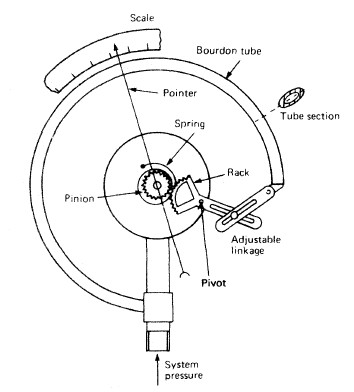
Fig 4. Bourdon tube pressure gauge
Where can use the Bourdon Tube?
Bourdon tubes are versatile pressure-sensing devices used in various industries and applications where the measurement of pressure is essential. Here are some common places and industries where Bourdon tubes are used:
- Industrial Manufacturing:
- Monitoring fluid pressure in hydraulic and pneumatic systems.
- Pressure measurement in manufacturing processes, such as in the plastics, rubber, and metalworking industries.
- Pressure gauges on industrial machinery and equipment.
- Petrochemical and Chemical Industry:
- Measuring pressure in pipelines, tanks, and vessels containing gases or liquids.
- Pressure monitoring in refineries and chemical processing plants.
- Oil and Gas:
- Monitoring wellhead pressures and downhole pressures in oil and gas exploration and production.
- Pressure measurement in pipelines and storage facilities.
- Aerospace:
- Pressure measurement in aircraft hydraulic systems.
- Monitoring pressure in spacecraft and rockets.
- Pharmaceutical and Biotechnology:
- Pressure monitoring in pharmaceutical manufacturing processes.
- Pressure sensors for bioreactors and fermentation tanks.
- Food and Beverage:
- Pressure measurement in food processing equipment, such as pasteurizers and autoclaves.
- Monitoring pressure in beverage bottling and canning processes.
- HVAC (Heating, Ventilation, and Air Conditioning):
- Pressure gauges in HVAC systems for monitoring air and refrigerant pressures.
- Automotive Industry:
- Pressure sensors in automotive engines and braking systems.
- Tire pressure monitoring systems (TPMS) in vehicles.
- Medical Devices:
- Pressure sensors in medical equipment like ventilators and blood pressure monitors.
- Pressure monitoring in anesthesia machines.
- Utilities:
- Pressure measurement in water and gas distribution networks.
- Monitoring pressure in steam boilers and turbines in power plants.
- Research and Laboratories:
- Scientific experiments and research applications that require precise pressure measurement.
- Marine Industry:
- Monitoring pressure in ship systems, including hydraulics and ballast tanks.
- Environmental Monitoring:
- Pressure sensors in weather stations and environmental monitoring equipment.
- Pressure Relief and Safety Devices:
- Pressure gauges in safety relief valves and pressure regulators to ensure safe operation.
Bourdon tubes are valued for their reliability, accuracy, and durability in pressure measurement applications. They are available in various designs and materials to accommodate different pressure ranges and environments, making them suitable for a wide range of industries and applications where pressure monitoring is critical.
A real example of using Bourdon Tube
A real-world example of the use of a Bourdon tube can be found in a common household pressure gauge, such as the one used for measuring tire pressure in vehicles. Here's how a Bourdon tube operates in this context:
Application: Tire Pressure Gauge
Description: A tire pressure gauge is a handheld device used to measure the air pressure inside vehicle tires.
Operation:
- The Bourdon tube is a critical component of the tire pressure gauge.
- The gauge typically has a cylindrical body with a gauge dial and a pressure release button.
- Inside the gauge, a Bourdon tube is connected to a pressure inlet (the part that attaches to the tire valve).
- When you press the gauge onto the valve stem of the tire and push the gauge's plunger, it opens a valve in the gauge, allowing air from the tire to enter the Bourdon tube.
- As air from the tire enters the Bourdon tube, the pressure inside the tube increases.
- The Bourdon tube is designed to deform in response to this pressure increase, and it starts to straighten out from its curved shape.
- This deformation of the Bourdon tube is converted into the rotational movement of a pointer on the gauge's dial.
- The position of the pointer on the dial corresponds to the pressure inside the tire.
Pressure Range: Typically, tire pressure gauges are designed for measuring a range of pressures commonly found in vehicle tires, which can vary depending on the type of vehicle (e.g., cars, trucks, bicycles) and the specific application (e.g., road, off-road, racing).
Pros:
- Provides a quick and accurate measurement of tire pressure.
- Portable and easy to use.
- No need for external power sources or batteries.
- Bourdon tubes are durable and reliable, making the gauge suitable for a range of conditions.
Cons:
- May require some calibration over time to ensure accuracy.
- Limited to measuring pressures within a specific range.
- The gauge may wear out or become less accurate over time with heavy use.
In this example, the Bourdon tube is a fundamental component of the tire pressure gauge, and its deformation in response to pressure changes enables users to easily and accurately monitor their tire pressure, which is crucial for vehicle safety, fuel efficiency, and tire longevity.
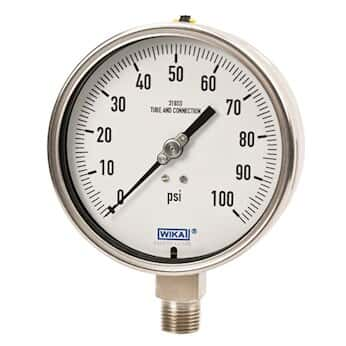
Fig 5. Bourdon tube pressure gague
Installation and Maintenance
How can use the Bourdon Tube?
Using a Bourdon tube typically involves incorporating it into a pressure measurement instrument or system, such as a pressure gauge, pressure transmitter, or pressure switch. Here are the general steps for using a Bourdon tube-based pressure measurement device:
- Prepare the Bourdon Tube Instrument:
- Ensure the Bourdon tube instrument is in good condition, and free from damage or deformities.
- Check that the instrument is suitable for the pressure range you intend to measure. Different Bourdon tube designs are used for various pressure ranges.
- Prepare the Pressure Source:
- If you are measuring the pressure of a gas or liquid, ensure the pressure source is properly connected and pressurized. This could be a pipeline, a container, a hydraulic system, or any other source of pressure.
- Connect the Bourdon Tube:
- Attach the Bourdon tube instrument to the pressure source using the appropriate fittings or connectors. Ensure a secure and leak-free connection.
- Reading the Pressure:
- If you are using a Bourdon tube pressure gauge, observe the position of the pointer or the digital display on the gauge dial. This indicates the pressure value.
- If you are using a Bourdon tube pressure transmitter, the measured pressure may be sent as an electrical signal (e.g., 4-20 mA) to a control system or display device.
- Interpret the Reading:
- Read and record the pressure value indicated by the Bourdon tube instrument. Ensure that you are using the appropriate units of measurement (e.g., psi, bar, kPa).
- Pressure Release:
- If necessary, release the pressure from the Bourdon tube instrument to disconnect it safely from the pressure source.
- Maintenance and Calibration:
- Periodically check and calibrate the Bourdon tube instrument to ensure accuracy. Calibration may be required depending on the specific application and the instrument's usage.
- Safety Considerations:
- Be mindful of safety precautions when working with pressurized systems to prevent accidents or injuries. Always follow safety guidelines and wear appropriate personal protective equipment.
It's important to note that Bourdon tube instruments are designed for specific pressure ranges and may have different designs and features depending on their intended application. Therefore, it's crucial to use the appropriate Bourdon tube instrument for your specific pressure measurement needs and to follow the manufacturer's instructions and guidelines for safe and accurate operation.
Safety Tips
Safety is paramount when working with pressure systems, including those that use Bourdon tube instruments. Here are some important safety tips to consider when using Bourdon tube-based pressure measurement devices:
- Follow the Manufacturer's Instructions:
- Always adhere to the manufacturer's guidelines and recommendations for the specific Bourdon tube instrument you are using.
- Training and Competency:
- Ensure that personnel operating the pressure measurement equipment are properly trained and competent in handling such instruments.
- Personal Protective Equipment (PPE):
- Wear appropriate PPE, such as safety goggles, gloves, and hearing protection, as needed for the specific application.
- Pressure Release:
- Before disconnecting a Bourdon tube instrument from a pressurized system, release the pressure slowly and safely to avoid sudden releases that can cause injury or damage.
- Pressure Relief Valves:
- Make sure pressure systems have relief valves or pressure-limiting devices in place to prevent over-pressurization, which can lead to equipment failure and accidents.
- Inspect Equipment:
- Regularly inspect the Bourdon tube instrument for signs of damage or wear. Replace or repair damaged instruments promptly.
- Calibration and Accuracy:
- Periodically calibrate pressure measurement instruments to maintain accuracy. Follow a documented calibration schedule.
- Pressure Ranges:
- Ensure that the Bourdon tube instrument used is appropriate for the pressure range you are measuring. Using an instrument outside its specified range can lead to inaccurate readings and potential damage.
- Leak Testing:
- Conduct leak tests on connections and fittings to ensure there are no leaks in the system that could compromise safety.
- Pressure Isolation:
- When making connections or adjustments, ensure that the pressure is isolated and depressurized before working on the system.
- Proper Venting:
- Be aware of the potential for trapped pressure in the system and take appropriate steps to vent or bleed the pressure before opening or servicing.
- Emergency Procedures:
- Have clear emergency procedures in place in case of sudden pressure releases or accidents. Ensure personnel know how to respond to pressure-related emergencies.
- Labeling and Signage:
- Use clear labeling and signage to indicate pressurized systems and potential hazards.
- Safety Interlocks:
- In automated systems, consider the use of safety interlocks that prevent operation when pressure conditions are unsafe.
- Documentation:
- Maintain records of pressure measurements, maintenance, and inspections. Document any changes made to the system.
- Training and Communication:
- Ensure that all personnel working with pressure systems are informed about safety procedures and can communicate effectively during operations.
- Environmental Considerations:
- Be aware of the environmental impact of pressure systems and follow any environmental regulations or guidelines that apply.
- Supervision:
- Have a responsible person oversee and supervise pressure-related operations to ensure safety protocols are followed.
Safety should always be the top priority when working with pressurized systems and Bourdon tube instruments. Adhering to safety practices and protocols helps prevent accidents, injuries, and equipment damage.
How can calibrate the Bourdon Tube?
Calibrating a Bourdon tube-based pressure gauge or instrument is essential to ensure its accuracy and reliability. Here's a general procedure for calibrating a Bourdon tube instrument:
Note: Calibrating pressure instruments often requires specialized equipment and expertise. It may be performed by trained personnel or specialized calibration laboratories. Always follow the manufacturer's instructions and any applicable safety guidelines.
Tools and Equipment Needed:
- A reference pressure source with known and traceable accuracy.
- Calibration adapters or fittings to connect the reference source to the Bourdon tube instrument.
- A pressure measuring instrument with higher accuracy than the Bourdon tube instrument being calibrated.
- A calibration certificate for the reference source.
Calibration Procedure:
- Preparation:
- Ensure that the Bourdon tube instrument is clean, free from debris, and in good condition.
- Verify that the reference pressure source is calibrated and has a valid calibration certificate.
- Setup:
- Connect the reference pressure source to the Bourdon tube instrument using appropriate adapters or fittings.
- Connect the pressure measuring instrument (calibrator) to the same reference source.
- Ensure all connections are tight and leak-free.
- Zero Point Calibration:
- Apply zero pressure (atmospheric pressure) to the Bourdon tube instrument.
- Record the reading displayed on the Bourdon tube instrument.
- Compare the Bourdon tube reading with the known atmospheric pressure value. Adjust the gauge if there is an offset.
- Full-Scale Calibration:
- Apply a full-scale pressure (the maximum pressure the gauge is designed to measure) to the Bourdon tube instrument.
- Record the reading displayed on the Bourdon tube instrument.
- Compare the Bourdon tube reading with the known full-scale pressure value. Adjust the gauge if necessary.
- Intermediate Calibration Points:
- Depending on the required accuracy and calibration specifications, you may perform additional calibration points at intermediate pressures.
- Record the readings and compare them to the known pressure values, making adjustments as needed.
- Repeatability and Hysteresis:
- Conduct tests for repeatability and hysteresis by applying and releasing pressure multiple times at various points within the gauge's range.
- Ensure that the gauge consistently returns to the same reading when pressure is applied and released. Make adjustments if necessary.
- Documentation:
- Record all calibration data, including the Bourdon tube instrument's serial number, date of calibration, reference source data, and the readings obtained at each calibration point.
- Prepare a calibration certificate with all relevant information.
- Adjustment:
- If adjustments are necessary to bring the Bourdon tube instrument into calibration, follow the manufacturer's guidelines for making these adjustments. Adjustments may involve mechanisms like screws or trim pots.
- Final Verification:
- After adjustments, repeat the calibration procedure to ensure that the gauge now meets the specified accuracy requirements.
- Calibration Certificate:
- Issue a calibration certificate with details of the calibration process, including before-and-after readings, adjustments made, and any other relevant information.
- Sign and date the certificate.
- Sticker or Label:
- Apply a calibration sticker or label to the Bourdon tube instrument, indicating the date of calibration, the next calibration due date, and the signature of the person who performed the calibration.
- Calibration Records:
- Maintain a record of all calibration certificates and calibration history for the Bourdon tube instrument.
It's important to note that calibration procedures may vary depending on the specific Bourdon tube instrument, the manufacturer's recommendations, and the requirements of the industry or application in which it is used. If you are not familiar with calibration processes, it is advisable to seek the services of a professional calibration laboratory or technician to ensure accurate and traceable results.
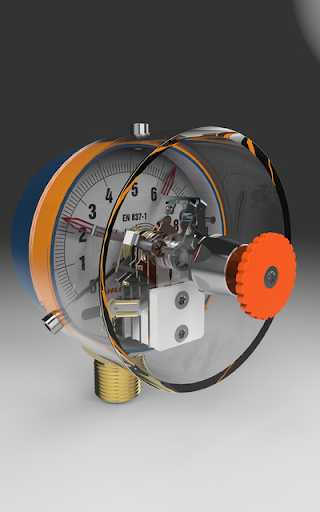
Fig 6. Bourdon tube pressure sensor
Is Bourdon Tube an accurate device?
Bourdon tubes are generally considered accurate pressure measurement devices when used within their specified pressure range and when properly calibrated and maintained. However, the accuracy of a Bourdon tube-based instrument can vary depending on several factors:
- Quality of Manufacturing: The accuracy of a Bourdon tube instrument is influenced by the quality of its construction. High-quality manufacturing processes and materials can result in more accurate and reliable devices.
- Calibration: Regular calibration is essential to ensure accuracy. Bourdon tube instruments need to be calibrated against known pressure standards to confirm their accuracy and make any necessary adjustments.
- Pressure Range: Bourdon tubes are designed for specific pressure ranges. Instruments used outside their designed range may not provide accurate readings.
- Wear and Tear: Over time, wear and tear can affect the accuracy of a Bourdon tube instrument. This can include mechanical wear, fatigue of the Bourdon tube material, or damage to internal components.
- Environmental Conditions: Environmental factors such as temperature fluctuations, vibration, and humidity can influence the accuracy of pressure measurements.
- Calibration Frequency: The frequency of calibration is essential. Instruments that experience significant usage or exposure to harsh conditions may require more frequent calibration to maintain accuracy.
- Instrument Design: The design of the Bourdon tube instrument, including the number of contact points, the quality of linkages, and the overall mechanical design, can impact accuracy.
- Human Error: Errors in the operation of the instrument or in the reading of measurements can affect accuracy.
To ensure the accuracy of a Bourdon tube-based pressure instrument, it is important to:
- Calibrate the instrument regularly according to manufacturer recommendations and industry standards.
- Use the instrument within its specified pressure range.
- Store and operate the instrument under appropriate environmental conditions.
- Follow proper handling and operating procedures.
- Inspect the instrument for signs of wear or damage and address any issues promptly.
Overall, Bourdon tubes are known for their reliability and have been widely used in various industries for many years. When properly maintained and calibrated, they can provide accurate pressure measurements for a range of applications. However, like any measurement device, their accuracy depends on proper usage, maintenance, and calibration practices.
What are the Advantages and Disadvantages of Bourdon Tube?
Bourdon tubes are commonly used in pressure measurement instruments and systems due to their advantages, but they also have some limitations. Here are the advantages and disadvantages of Bourdon tubes:
Advantages:
- Reliability: Bourdon tubes are known for their reliability and durability. They can withstand harsh industrial environments and continue to provide accurate readings over a long lifespan.
- Accuracy: When properly calibrated and used within their specified pressure range, Bourdon tubes can provide accurate pressure measurements for a wide range of applications.
- Wide Pressure Range: Bourdon tubes are available in various designs to cover a wide range of pressure measurements, from low to high pressures.
- No External Power: They operate without the need for external power sources such as electricity or batteries, making them suitable for remote or hazardous locations.
- Ease of Use: Bourdon tube pressure gauges are user-friendly and easy to read. The pointer on the gauge dial directly indicates the pressure value.
- Cost-Effective: Bourdon tubes and instruments are often cost-effective compared to some other types of pressure sensors, making them a practical choice for many applications.
- Versatility: Different Bourdon tube designs are available to meet specific application requirements, including helical, spiral, and diaphragm types.
- Mechanical Safety Indicator: In many Bourdon tube pressure gauges, the visible movement of the pointer provides a clear indication of pressure changes, making it easy to detect leaks or pressure anomalies.
Disadvantages:
- Limited Sensitivity: Bourdon tubes may have limited sensitivity, especially at lower pressure ranges. They might not be suitable for applications requiring extremely precise measurements of low pressures.
- Temperature Sensitivity: The accuracy of Bourdon tube instruments can be affected by temperature fluctuations. Temperature changes can cause expansion or contraction of the tube material, leading to measurement errors.
- Nonlinear Response: Bourdon tubes inherently have a nonlinear response to pressure changes, especially at the higher end of their range. Calibration is necessary to correct for this nonlinearity.
- Mechanical Wear: Over time, mechanical wear and fatigue of the Bourdon tube material can affect accuracy and reliability. Regular maintenance and calibration are essential.
- Pressure Shock: Bourdon tubes can be sensitive to pressure shocks or sudden pressure changes, which can lead to mechanical damage or incorrect readings.
- Limited to Mechanical Indication: Bourdon tubes provide mechanical indications, which may not be suitable for applications requiring electronic data acquisition and remote monitoring.
- Limited Remote Monitoring: Monitoring and recording Bourdon tube readings remotely may require additional equipment, such as pressure transmitters.
- Vibration Sensitivity: In some applications with significant vibrations, Bourdon tubes may be less suitable as they can produce erratic readings.
In summary, Bourdon tubes are widely used due to their reliability and cost-effectiveness, especially in industrial settings. However, their limitations, such as limited sensitivity and temperature sensitivity, make them better suited for certain types of pressure measurement applications than others. Careful selection, proper maintenance, and calibration are essential to maximize their advantages while mitigating disadvantages.
What are the important factors in choosing the right Bourdon Tube?
Choosing the right Bourdon tube for a specific pressure measurement application is crucial to ensure accurate and reliable results. Several important factors should be considered when making this selection:
- Pressure Range: Determine the range of pressures that need to be measured. Different Bourdon tube designs are suited for different pressure ranges. Ensure that the chosen Bourdon tube can operate effectively within the required pressure range.
- Accuracy Requirements: Define the required level of accuracy for your application. Bourdon tubes have varying levels of accuracy, so select an instrument that meets or exceeds your accuracy needs.
- Environment and Conditions:
- Temperature: Consider the operating temperature range. Ensure that the Bourdon tube material can withstand the temperature variations encountered in your application.
- Vibration and Shock: If the environment includes significant vibrations or pressure shocks, choose a Bourdon tube instrument designed to handle such conditions.
- Corrosion: In corrosive environments, select materials (e.g., stainless steel, Inconel) that are resistant to corrosion.
- Media Compatibility: Ensure that the Bourdon tube and its components are compatible with the type of fluid (gas or liquid) being measured. Some fluids can be chemically aggressive and may require special materials or coatings.
- Mounting and Installation:
- Consider the available space for mounting the Bourdon tube instrument. Ensure it fits within the allotted space.
- Determine the type of mounting (bottom, back, panel, etc.) that is most convenient for your application.
- Response Time: Bourdon tubes have a certain response time to pressure changes. Consider the required response time for your application, especially if rapid pressure fluctuations are involved.
- Shock Resistance: If the application involves pressure surges or shock loads, select a Bourdon tube instrument designed to withstand such conditions.
- Regulatory and Certification Requirements: Ensure that the chosen Bourdon tube instrument complies with industry standards and regulatory requirements specific to your application, if applicable. Look for instruments with relevant certifications.
- Maintenance and Calibration: Consider the ease of maintenance and calibration. Instruments that are easy to maintain and calibrate can help ensure long-term accuracy and reliability.
- Cost: Evaluate the cost-effectiveness of the Bourdon tube instrument while keeping in mind that higher-quality, more accurate instruments may justify a higher initial cost due to improved performance and longevity.
- Customization: In some cases, custom-designed Bourdon tube instruments may be necessary to meet specific requirements. Consider the availability of customization options from the manufacturer.
- Manufacturer Reputation: Choose a reputable manufacturer known for producing reliable and accurate Bourdon tube instruments. Manufacturer support, warranty, and service can be important considerations.
- Compatibility with Other Instruments: Ensure that the Bourdon tube instrument can be easily integrated into your measurement system, including compatibility with other instruments and control systems.
- Safety: In applications where safety is paramount, consider features such as safety relief valves or pressure-limiting devices.
By carefully assessing and considering these factors, you can select the right Bourdon tube instrument that best meets the requirements of your pressure measurement application, ensuring accurate and reliable results. It may be beneficial to consult with experts or manufacturers to make an informed choice.
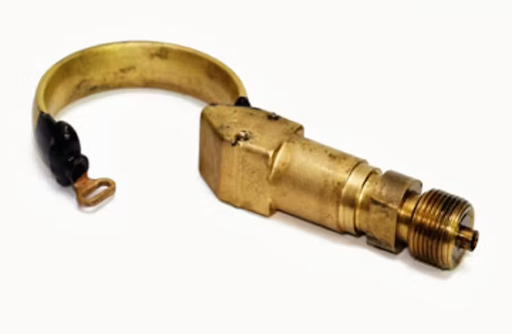
Fig 7. Bourdon tube for pressure gauge
Five Top Brands that Manufacture the Bourdon Tubes
Several reputable manufacturers produce Bourdon tube-based pressure measurement instruments. Here are five top brands known for their quality and reliability in manufacturing Bourdon tube instruments:
- Ashcroft:
- Ashcroft is a well-established brand with a long history in pressure measurement technology. They offer a wide range of pressure gauges and transmitters, including those based on Bourdon tubes. Ashcroft is known for its high-quality instruments used in various industries.
- WIKA:
- WIKA is a global leader in pressure and temperature measurement. They manufacture a diverse range of pressure instruments, including Bourdon tube pressure gauges and transmitters. WIKA is recognized for its precision and innovation in instrumentation.
- Dwyer Instruments:
- Dwyer Instruments is known for its extensive selection of pressure and flow control instruments. They produce Bourdon tube pressure gauges, switches, and transmitters used in HVAC, industrial, and process applications.
- AMETEK Sensors, Test & Calibration (STC):
- AMETEK STC manufactures a wide variety of pressure measurement instruments, including Bourdon tube gauges, transducers, and calibrators. They serve industries such as aerospace, oil and gas, and automotive.
- NOSHOK:
- NOSHOK specializes in pressure, temperature, and level measurement solutions. They offer Bourdon tube pressure gauges and transmitters, along with a range of other instrumentation products for industrial applications.
These brands are known for their commitment to quality, accuracy, and reliability in pressure measurement instruments. When choosing a Bourdon tube instrument, it's essential to consider your specific application requirements and select a reputable manufacturer that can provide the instrument that best suits your needs.
Conclusion
In conclusion, Bourdon tubes are versatile and reliable pressure measurement devices widely used across various industries and applications. They operate on a simple yet effective mechanical principle, making them suitable for both low and high-pressure measurements. Here are the key takeaways:
- Bourdon Tube Principle: Bourdon tubes work on the principle that a curved, elastic tube straightens or deforms in response to changes in internal pressure. This deformation is translated into mechanical movement, which is used to indicate pressure on a gauge or provide an output signal in a transmitter.
- Types of Bourdon Tubes: Bourdon tubes come in various designs, including C-type, helical, spiral, diaphragm-type, and more, each suited for specific pressure ranges and applications.
- Advantages of Bourdon Tubes:
- Reliability and durability.
- Cost-effectiveness.
- Versatility for a wide range of pressure measurements.
- No need for external power sources.
- Ease of use and clear mechanical indication.
- Disadvantages of Bourdon Tubes:
- Limited sensitivity at low pressures.
- Temperature and environmental sensitivity.
- Mechanical wear over time.
- Nonlinearity in response.
- Sensitivity to pressure shocks.
- Choosing the Right Bourdon Tube: Several factors should be considered when selecting a Bourdon tube instrument, including pressure range, accuracy requirements, environmental conditions, media compatibility, and regulatory compliance.
- Calibration and Maintenance: Regular calibration and maintenance are crucial to ensure the accuracy and reliability of Bourdon tube instruments. Calibration should be performed by trained personnel using traceable standards.
- Top Brands: Reputable manufacturers known for producing high-quality Bourdon tube instruments include Ashcroft, WIKA, Dwyer Instruments, AMETEK STC, and NOSHOK.
- Safety Considerations: Safety should always be a top priority when working with pressurized systems and Bourdon tube instruments. Proper training, personal protective equipment, and adherence to safety protocols are essential.
In summary, Bourdon tubes continue to be a fundamental technology for pressure measurement due to their simplicity, reliability, and cost-effectiveness. Selecting the right Bourdon tube instrument and maintaining it properly can ensure accurate pressure measurements in a wide range of industrial and scientific applications.
1. What is a Bourdon tube?
- A Bourdon tube is a curved, elastic tube that is used as a primary sensing element in pressure measurement instruments. It deforms in response to changes in internal pressure, enabling the measurement of pressure.
2. How does a Bourdon tube work?
- A Bourdon tube works on the principle that as the pressure inside the tube increases, it tends to straighten or deform. This deformation is translated into mechanical movement, which is used to indicate pressure on a gauge or provide an output signal in a transmitter.
3. What are the common types of Bourdon tubes?
- Common types of Bourdon tubes include C-type, helical, spiral, diaphragm-type, and others, each designed for specific pressure ranges and applications.
4. What are the advantages of using Bourdon tubes?
- Advantages include reliability, cost-effectiveness, versatility for a wide range of pressure measurements, no need for external power sources, ease of use, and clear mechanical indication.
5. What are the disadvantages of Bourdon tubes?
- Disadvantages include limited sensitivity at low pressures, temperature and environmental sensitivity, mechanical wear over time, nonlinearity in response, and sensitivity to pressure shocks.
6. How do you choose the right Bourdon tube instrument?
- Factors to consider include pressure range, accuracy requirements, environmental conditions, media compatibility, regulatory compliance, and more. Select based on specific application needs.
7. How often should Bourdon tube instruments be calibrated?
- Calibration frequency depends on the application and industry standards. In many cases, annual calibration is recommended, but critical applications may require more frequent calibration.
8. Are Bourdon tube instruments suitable for high-pressure applications?
- Yes, certain types of Bourdon tubes, such as helical and spiral designs, are suitable for high-pressure measurements and can withstand extreme pressure conditions.
9. Do Bourdon tubes require external power sources?
- No, Bourdon tubes do not require external power sources. They operate solely based on the mechanical deformation of the tube in response to pressure changes.
10. Are Bourdon tube instruments used in hazardous environments?
- Yes, Bourdon tube instruments are used in hazardous environments, but it's essential to choose instruments designed for such conditions, including explosion-proof or intrinsically safe models, as needed.
References
https://tameson.com/pages/bourdon-tube-pressure-gauge
http://www.machineryspaces.com/Bourdon-tube-pressure-gauge.html
https://www.pumpsandsystems.com/bourdon-tube-pressure-gauge-overview
Recent Posts
-
Booster Pump Troubleshooting and Maintenance: How to Fix and Prevent Common Issues
1. Introduction Imagine turning on your faucet only to be greeted with a weak trickle of water when …22nd Apr 2025 -
Energy-Efficient Booster Pumps: Selection and Tips for Maximizing Performance
1. Introduction Imagine never having to deal with fluctuating water pressure, noisy pumps, or skyroc …19th Apr 2025 -
Booster Pumps for Sustainable Water Systems: Irrigation and Rainwater Harvesting Solutions
1. Introduction Water scarcity is no longer a distant threat—it’s a reality affecti …16th Apr 2025

